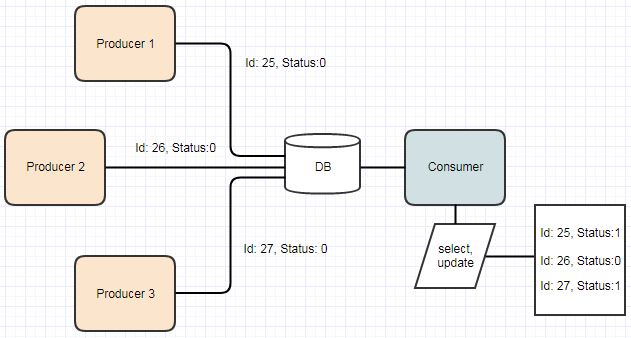Title is too broad but I couldn't find a more specific one, please feel free to change with better one.
I have a table which is working with sequences instead identity. I have three producer applications which are concurrently insert into table, and a consumer application select from table whose status are not processed and then process them and finally update rows as processed.
Consumer application has a rule that it does not process the row whose id (identity column value) is smaller than the id which lastly processed by itself
The problem is, although I have never presumed to happen, my consumer application is falling into this rule while it is running. (Rule developed for other purposes). To visualize;
Each application sends new data to the database and under normal circumstances, each one should be selected by consumer and processed (polling), however sometimes (inside a working period) I always have an unprocessed data in my table.
Here what my insert sp looks like which is commonly used by producers;
CREATE PROCEDURE spInsData
@Data VARCHAR(MAX)
AS
BEGIN
SET @Id = NEXT VALUE FOR dbo.sequenceId
INSERT INTO dbo.MyTable(Id, Data, Status)
VALUES (@Id, @Data, 0)
END
So I am thinking of that when Producer 2 and Producer 3 calls the stored procedure, they first get the sequence values. Then, when it comes to insert, somehow Producer 3 insertion is occured faster than the Producer 2. Then the consumer processes the the bigger id before the smaller one, so id 26 is never processed.
I hope I am clear about the problem. Could it be the problem as I explain or could it be something else? If it is about sequence, can I lock the whole process - get sequence and insert - for each consumer?


overtakingon the producer side (you might see some reduction if inline your local, i.e.INSERT INTO dbo.MyTable(..) VALUES(NEXT VALUE FOR ...). The consumer should perhaps consider tagging completed rows as "Processed" and then search for unprocessed rows, rather than being tightly coupled to the actual sequence id? – BullwhipIDENTITYorSEQUENCE. Treat the values as opaque blobs that happen to fit in numeric columns, you'll be okay. Rely on particular properties of the values assigned and you'll have issues (as you have here). – Roadability